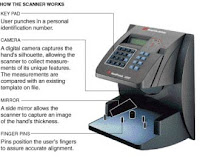I read a lot about "Innovation." Classes on innovation, books on innovation, b-school programs on innovation. Creating cultures of innovation. There is currently a huge mystique around innovation as if it's something terribly complex that must be studied and learned.
Here's a secret. Being innovative is incredibly simple. We are built for innovation. We only need to open our minds and look and listen to the things around us.
Here are two simple techniques that I live by everyday:
1)
"I wonder if...."For everything you see throughout the day, you should always be thinking about how things could be better. This applies to every store you enter, every service you engage, every interaction you experience, every thing you see as you walk or drive down the street.
"I wonder if...you could see the products better if this store had better lighting? I wonder if... LEDs would work better? I wonder if... a different color lighting might work?"
"I wonder if... I would feel better about this company if the customer service person had a smile in her voice?"
"I wonder if... I'd be more likely to buy this product again if the @#$% package was easier to open? I wonder if they could seal it with a different kind of material so that it would still be strong but easy to open?"
You don't have to do anything with your wonders. The act of curiosity develops your mind to always be creating ideas and innovations for improvement. Soon you'll be able to "wonder if" for every facet of your own business as well.
Plus some of your wonders about other interactions will translate over to ideas for your own life or business.
2)
Connect All Dots to You. Every time you read a book, study an article, listen to a podcast, watch a video, or sit in on a webinar keep your mind open for a kernel of wisdom that can be applied (in a completely new way) to you. Even if the topic seems to be absolutely unrelated. Always be thinking, "How could this connect to me? What could we do with something like this?"
For example, some years ago I was speaking at a Conference Board conference on Recruiting and Retention. In between speaking I sat in on a couple of sessions. There was one interesting session conducted by a Sr. HR Manager for a major corporation. He was talking about various recruitment techniques his company was using successfully.
I was no longer involved in recruiting but as a former practitioner it was interesting to hear what the big companies were up to. At one point the speaker talked about their "rebounding" efforts. He talked about how they had been very successful in bringing back high performers using a postcard campaign. The postcard had a field of grass and asked, "Is the grass greener?" (Love that!) It invited the high performers to re-explore opportunities with the company. I can't recall the details now but it was very successful. A large number of high performers returned and their metrics showed they were even better and more loyal employees the second time around.
Interesting. But what did this idea have to do with me? I was no longer involved in recruiting as I was earlier in my career. I was now running an HR technology company that automated the exit interview process.
But wait ---
Could the exit interview process be used to facilitate this "rebounding" effort? If the exit interview is the last place we "talk" to the departing employee, could we could find out if high-performers would be open to the company keeping in touch to see if the grass is greener? Could we use the system to automatically schedule a follow-up so HR didn't have to keep track of when to send out postcards? And thus the idea for our innovative "Rebounding Module" was developed.
In 2003, I watched the HR Talk online bulletin board for SHRM members as the members were attempting to match newbies in HR with more senior HR mentors. People were making posts with their background and desire to be a mentor or mentee. Some of the old-timers on the board were attempting to match people together. It was a great idea to match members up in 1 to 1 mentorships. Watching this though I couldn't help but notice how slow and cumbersome the process was. It was a lot of work for a handful of volunteers. There had to be a better way.
At the same time, we were seeing that many of the problems being identified on our clients' exit interviews could be solved or minimized by Mentoring. The spark was lit and Mentor Scout was born. (And subsequently donated to the SHRM HR Talk group.)
In 2006, MySpace was all the rage. Every where I looked, everything I read had mention of MySpace. I wasn't a teenager and I'm not all that into music -- but could some of the concepts of MySpace be borrowed to solve problems or enhance my field of Human Resources? The result was Mentor Scout's Talent Networking Edition, one of the very first internal corporate social networking platforms for employee collaboration, information sharing, recognition and retention.
How do you know if your ideas are innovative? One of the amazing things about how our minds and bodies work is that when you get a truly inspiring idea, it comes with a burst of energy. (Lucky us!) I don't know the biology behind it (adrenaline?) but presumably the energy is a way to help us immediately begin implementing the idea. Be forewarned, the energy may fade by the following day so when you get the idea and the energy burst, write the idea down right away with as much detail as you can. More ideas will continue to flow for a few hours after the initial idea.
Once you get into the innovation habit, you'll have many more ideas than you have capacity to achieve them. I wish I could give you advice on how to handle an overload of ideas but my idea notebook is overflowing right now. We'll have to save the post on prioritization for another day.
Related Posts from the Archives:
1.
Mind Your Own Business2.
Does Birth Order Influence Acceptance of New Ideas?3.
Are you LDD? Why We Are All Becoming Listening Deficient 4.
Thinking Strategically 5.
Ten HR Ideas to Beat the Year End Blahs [Dec 2008]










































